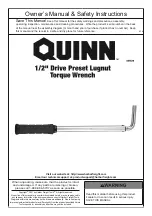
instructions for
On-vehicle micrO brake pipe flaring
tOOl set
model no:
pft11.v2
thank you for purchasing a sealey product. manufactured to a high standard, this product will, if used according to these
instructions, and properly maintained, give you years of trouble free performance.
IMPORTANT:
PLEASE READ THESE INSTRUCTIONS CAREFULLY. NOTE THE SAFE OPERATIONAL REQUIREMENTS, WARNINGS & CAUTIONS. USE
THE PRODUCT CORRECTLY AND WITH CARE FOR THE PURPOSE FOR WHICH IT IS INTENDED. FAILURE TO DO SO MAY CAUSE DAMAGE AND/OR
PERSONAL INJURY AND WILL INVALIDATE THE WARRANTY. KEEP THESE INSTRUCTIONS SAFE FOR FUTURE USE.
1. safetY
Warning!
ensure Health & safety, local authority and general workshop practice requirements are adhered to when using this
equipment. familiarise yourself with the application and limitations, as well as the potential hazards of the set.
9
this set is suitable for steel pipe.
9
maintain the set in good condition.
9
replace or repair damaged parts. use genuine parts only. unauthorised parts may be dangerous and will invalidate the warranty.
9
locate the flaring set in a suitable work area, keep the area clean and tidy and ensure there is adequate lighting.
Warning!
Always wear approved eye or face protection when using the flaring tools.
9
Keep children and unauthorised persons away from the working area.
8
DO nOt
use the set for any purpose other than for which it is designed.
8
DO nOt
use the set if any parts are damaged or missing as this may cause failure and/or personal injury.
8
DO nOt
allow untrained persons to use the set.
8
DO nOt
attempt to flare piping when you are tired, under the influence of alcohol, drugs or intoxicating medication.
9
When not in use clean set components, replace in case and store in a safe, dry, childproof area.
▲
remember! the safe operation of a vehicle, or other equipment, may well depend on the quality of the flare produced. Discard
any flare which is incorrectly formed.
Warning!
the warnings, cautions and instructions discussed in this manual cannot cover all possible conditions and situations that may
occur. it must be understood that common sense and caution are factors which cannot be built into this product, but must be applied by
the operator.
2. intrODuctiOn
Produces accurate automotive sAe and din flares on 3/16” and 4.75mm pipes
respectively. lightweight body makes it ideal for splicing in replacement sections
of brake pipe on-vehicle. suitable for steel pipes. supplied in carry case.
3. OperatiOn
Warning! ensure you are familiar with the various types of flare
before using this equipment.
Warning!
Before using the flaring kit, ensure that you have read and
understood the safety instructions in section 1.
3.1.
preparatiOn Of the brake pipe
3.1.1.
the end of the pipe must be cut square.
3.1.2.
the outside edge of the pipe must be chamfered to approximately
0.25mm x 45º.
3.1.3.
if the pipe is plastic covered, this must be cut back for 6mm from the
end of the pipe to be flared. ensure the pipe is not scored or any metal
removed during this operation.
DO nOt
use abrasive cloth.
note:
A spot of grease on the end of the punch helps the flare process.
3.2.
creatiOn Of 3/16” sae single flare
3.2.1.
use the sAe tool, stop and double ended punch as shown in fig.1.
3.2.2.
screw the stop into the tool.
3.2.3.
slide the tool onto pipe.
3.2.4.
tighten the locking screws by hand, just enough to grip the pipe.
impOrtant Do not over tighten at this stage or the stop will
damage the pipe.
3.2.5.
screw the stop into the tool until fully tightened. (A 17mm ratchet
spanner is recommended, but not included.)
3.2.6.
tighten the locking screws fully to clamp the pipe. (A 10mm ratchet
spanner is recommended, but not included.)
i
mpOrtant if the locking screws are not tight enough then the pipe
will push back during the flare process and will not produce the
correct flare.
Pft11.V2 | issue 1 30/11/16
Original Language Version
© Jack sealey limited




















